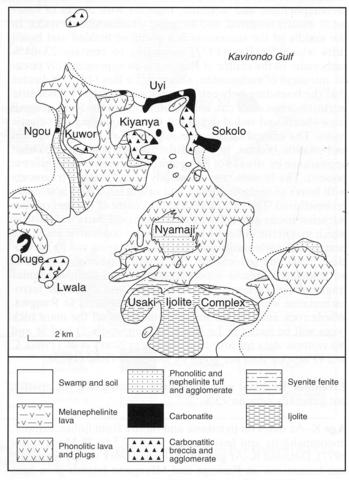stripes
The principal concentration of carbonatites on the Wasaki Peninsula is around the northeastern corner, particularly at Sokolo, Uyi and Kiyanya. Other carbonatites are the Okuge (Kuge, Tuige), Angalo, Ngou, Kuwor and Lwala bodies and numerous carbonatite blocks are found in rocks of the Nyamaji volcano. Le Bas (1977) divides the carbonatites into a younger group of Sokolo and Okuge, which are younger than the Nyamaji complex, and an older group that predates that centre. The carbonatite activity is divided by Le Bas (1977) into four stages: (1) fenitization, shattering of the basement granodiorite, the production of orthoclasite and trachyte and the emplacement of sovite. (2) Underground explosive brecciation, development of an agglomerate diatreme cutting the breccia, extrusion of tuffs and agglomerates and intrusion of alvikites. (3) Intrusion of ferrocarbonatite veins, some containing uranium and rare earth element minerals and many fluorite. (4) Intrusion of further carbonatites. The sovite of stage (1) contains some xenoliths of aegirine syenite and crystals of aegirine, biotite, abundant apatite and pyrochlore. The last carbonatites are rather scarce alvikite veins up to 10 cm across with magnetite and a little fluorite. On Sokolo Point on the eastern side of the Wasaki carbonatite complex are other carbonatites that Le Bas (1977) consider to be younger. They form a ring structure and have been divided into four groups. The earliest, and by far the most extensive, is a coarse sovite with some biotite, apatite and aegirine. This is cut by alvikite dykes and cone sheets that form a circular structure and which on the eastern side of the intrusion are of exceptional abundance. There was then emplacement of thin, steeply dipping ferrocarbonatite cone-sheets, that comprise most of the central area; they contain synchysite and monazite. Within the ferrocarbonatites are thin veins of calcite carbonatite that contain a little baryte. The Okuge carbonatite is a small (500 m diameter), arcuate intrusion located southwest of the Wasaki Peninsula. It is built of numerous thin, vertical sheets and cylindrical intrusions of alvikite which wrap around a core of Nyanzian metabasalts. It contains accessory magnetite, phlogopite and apatite. There is a brecciated ferrocarbonatite dyke on the eastern side of the hill (Onuonga et al., 1997). In places it grades into ferrocarbonatitic breccia in which there are small monazite-rich patches. A study of C and O isotopes in Okuge is described by Onuonga et al. (1997) and Kalt et al. (1997) give Sr, Nd and Pb isotope data for three carbonatite samples from Okuge and two from Sokolo Point. A detailed account of fluid inclusions in apatite in sovite, Sokolo carbonatite and a carbonatite block in phonolite is given by Rankin (1975). Trace element data for three carbonatites are available in Barber (1974).
BARBER, C. 1974. The geochemistry of carbonatites and related rocks from two carbonatite complexes, south Nyanza, Kenya. Lithos, 7: 53-63.KALT, A., HEGNER, E. and SATIR, M. 1997. Nd, Sr, and Pb isotopic evidence for diverse lithospheric mantle sources of East African rift carbonatites. Tectonophysics, 278: 31-45.LE BAS, M.J. 1977. Carbonatite-nephelinite volcanism: an African case history. John Wiley, London. 347 pp.ONUONGA, I.O., FALLICK, A.E. and BOWDEN, P. 1997. The recognition of meteoric-hydrothermal and supergene processes in volcanic carbonatites, Nyanza Rift, western Kenya, using carbon and oxygen isotopes. Journal of African Earth Sciences, 25: 103-13.RANKIN, A.H. 1975. Fluid inclusion studies in apatite from carbonatites of the Wasaki area of western Kenya. Lithos, 8: 123-36.

